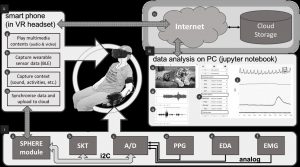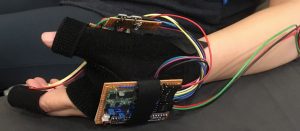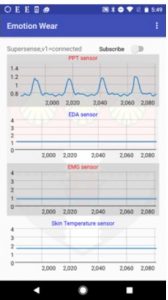emotionWear
A wearable that can predict human emotion…
The study of emotion has come a long and hard way with debates and disagreements since the early 19 century, where the research was started from a handful of scientists into an emerging research area now involving multidisciplinary researchers from all over the world. Although there is still no formal universal definition of ‘emotion’, the functions of emotion have been mostly agreed especially the several basic discrete emotions. Contemporary study reveals that emotion affects our health through homeostasis, and it is closely associated with the human cognitive behaviours such as decisions making, motivations and social interactions.
The perception of emotions is considered as an orchestration of the different functional parts of the human brain which then activates the biological systems of the human body and promotes different physiological changes though the autonomic nervous systems. Emotional physiological specificity has been proven by theoretical and empirical evidence as the signature for emotion recognition through a pattern matching methodology using statistical prediction model in machine learning. Wearable biosensors may be the best method for detecting the corresponding physiological changes associated with the various basic discrete emotions particularly in ambulatory emotion recognition applications.

Our emotionWear framework (figure 1) was specifically designed for emotion recognition based on a proposed concept of Response-Stimulus-Synchronisation (RSS). The stimuli, the context (environment, activities, etc.) and the physiological responses from wearable sensors are synchronised for easy data analysis using our glove (figure 2 and 3).
|
|
|
| This is aided by a modified SPW2 wearable to transfer the data over Bluetooth low Energy (BLE) to the Android app (figures 2 and 4).emotionWear can be applied to ambulatory emotion recognition through the Internet of Things (IoT) and Smart home environments where the concept of Disappearing User Interface (DUI) allows the conscious and unconscious sensing of human behavioural and physiological responses together with the sense of the associated contextual stimuli. Currently, we can detect “joy”, “fear”, and “disgust” with excellent levels of confidence. |
|
Please see our relevant Open Access peer reviewed scientific papers for full details:
Hui, T. K. L. and Sherratt, R. S. (2018) Coverage of emotion recognition for common wearable biosensors. Biosensors, 8 (2), 30. doi: 10.3390/bios8020030
Hui, T. K. L. and Sherratt, R. S. (2017) Towards disappearing user interfaces for ubiquitous computing: human enhancement from sixth sense to super senses. Journal of Ambient Intelligence and Humanized Computing, 8 (3). pp. 449-465. doi: 10.1007/s12652-016-0409-9



